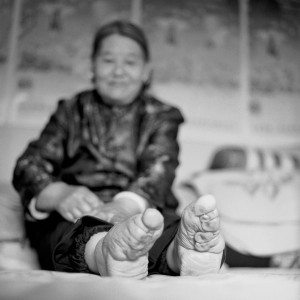
Source: Farrell, Jo: “Su Xi Rong (i),” 2014.
The image above, taken by Jo Farrell, depicts one of the last remaining women with bound feet, named Su Xi Rong. The black and white photography is clearly focused on the woman’s unbound, bare feet, while the rest of her body and face are blurred out. The image is a part of Jo Farrell’s collection, called the “Living History Project,” where she is documenting the lives of Chinese women who bound their feet and are still alive to tell their stories. She has been working on this personal project for a few years and many of the women she has photographed have died. This leads her to believe that it is imperative to celebrate and photograph the last remaining women because of their historical significance.
There are many important parts of this photograph to take into consideration regarding the construction of the image. The first is the lack of color in the photography, where Jo Farrell decided to use black and white photography. This technique is important to the composition of the photo because it is taking away any distractions that may pull the eye away from the main focus of the photo – the woman’s feet. The second important part of the construction of the photo is the focus on the bound feet, blurring out the rest of the image. These two things together create a focal point on the feet, placing an emphasis on them and their significance. By using black and white and focusing solely on the feet, the photographer has managed to show the importance of the feet and how this connects to society.
In Chinese society, bound feet were a symbol of high class, marriageability, gender, and sexuality, however, these feet were bound and concealed. When the foot was taken out of its binding, it shows the pain and deformation that women went through in order to achieve all of these things. This image strips away the fabric and binding and focuses on the foot itself. The viewer can see that many parts of the foot are deformed and broken. This significantly impacted the way the women moved and limited their mobility, representative of dependence on her family and her husband. This may be suggestive of why she is sitting down in the photograph.
The other interesting part of this photograph is the fact that the woman’s face is blurred out of the picture. This is representative of how the appearance of the woman’s feet were more significant than her true identity. The length of the feet determined her value, rather than her intellect or personality. This emphasis on outward appearance in order to impress men and find a husband ultimately stripped away many women’s identities, placing their value solely on their feet. She would hide her real body in bindings and fabric, deforming it in order to please men.
Although many women did not feel that they were forced to alter their bodies, they grew up in a society society dominated by males and were taught to bind their feet by their mothers. The seemingly simple nature of this photo is actually incorrect. Although the idea of foot binding seems like a simple act of fashion, it ultimately has many more meanings and truths behind it, that are not simply black and white or blurred out, just like the background of this photo.
a thoughtful analysis
-Marlaina
